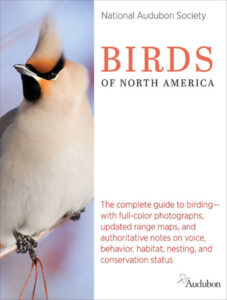 Published in tandem with the new National Audubon Society Trees of North America, their Birds of North America follows the same flex cover binding, large format layout, and graphic design pattern of its series sibling. However surpassing 900 pages as it does in order to contain the “more than 800 species” of birds presented in its species profiles, it is a much weightier tome than Trees. Not surprisingly, it is not by any means a field guide but rather a reference guide – a role it can be expected to play reasonably well for general readers who would like an attractive, extensively illustrated reference guide around the house.
Published in tandem with the new National Audubon Society Trees of North America, their Birds of North America follows the same flex cover binding, large format layout, and graphic design pattern of its series sibling. However surpassing 900 pages as it does in order to contain the “more than 800 species” of birds presented in its species profiles, it is a much weightier tome than Trees. Not surprisingly, it is not by any means a field guide but rather a reference guide – a role it can be expected to play reasonably well for general readers who would like an attractive, extensively illustrated reference guide around the house.
While I haven’t spent meaningful time putting this new book through its paces as I normally would a new field, or desk reference, guide by applying challenges to it, an initial look-through showed it to be entertaining and pleasant reading but sprinkled with items that brought questions quickly to mind.
As with any guidebook to species, be they birds, insects, trees, or what-have-you, I like to know what organizational taxonomy is being followed. The introductory section of Birds of North America indicates that it follows the American Ornithological Society‘s Checklist of North American Birds [sic], however it doesn’t specify through which supplement. Not a point that will trouble a general readership, but one that will immediately raise the hackles of serious birders and ornithologists.
The introductory material is similar in scope to that of Trees of North America, including once again placing an overview of taxonomic families oddly after the species accounts. All species are given a single page presentation, except for the Dark-eyed Junco (Junco hyemalis) that gets to pages. A number of rare and vagrant species to the continental forty-nine U.S. states and the Canadian provinces, best describable as “the stuff dreams are made of” for listers, are also included, as is the now extinct (yes, I know, “critically endangered”…) Ivory-billed Woodpecker (Campephilus principalus). All in all, a generous and curiosity-inspiring collection of avifauna, but I can’t help but wonder that whereas Trees of North America cut the total number of species in half for its species accounts – perhaps so as not to overwhelm a non-specialist, perhaps even inexperienced readership, Birds of North America “loads heavy,” which may result in many beginners taking up the guide either becoming confused among the possibilities, or misinterpreting the true chances of actually seeing a number of the species presented.
As a colorful, conversation-starting, perception-of-nature-expending overview of the bird species that can be found or that have been known to visit its designated range, Birds of North America nicely fits the bill. I expect I shall be seeing it on book shop shelves all across the U.S. and Canada for many years to come, as well as on the bookshelves of schools, organizational, and home libraries both near and far. I don’t expect that more experienced birders or naturalists will take to it as a primary reference – it isn’t intended as the type of definitive guide they most prize, nor should it be used as such – however I wouldn’t be at all surprised if many buy it nevertheless in order to maintain a high level of thoroughness to their respective personal libraries.
Available from:

